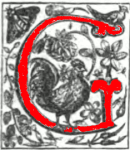 eorgie Gaskin was primarily a jeweller and metalworker who produced a significant body of ornamental pieces. Much of this work was done in collaboration with her husband, Arthur Gaskin, her influential teacher at the Birmingham Municipal School of Art. She also shared her husband’s interest in illustration, and between them the couple published extensively.
eorgie Gaskin was primarily a jeweller and metalworker who produced a significant body of ornamental pieces. Much of this work was done in collaboration with her husband, Arthur Gaskin, her influential teacher at the Birmingham Municipal School of Art. She also shared her husband’s interest in illustration, and between them the couple published extensively.
Her work included juveniles and Christmas cards, both in colour and in black and white, as well as laminated bindings for her own publications. Her earliest books, such as ABC: An Alphabet (1895), are closely linked to Arthur Gaskin’s neo-medieval creations; like his, her images are flat linear designs which reproduce the effects of incunabula and were influenced – as all her contemporaries were influenced – by William Morris’s essay on Gothic woodcuts. All of her work in black and white closely conforms to the Arts and Crafts aesthetic of beautiful functionality, though later publications towards the end of the nineties are better understood as versions of Art Nouveau, reproducing a tendency to abstraction which can be traced in the work of all of the Birmingham artists.


Two illustrations by Gaskin (a) A is for Apples, (b) V is for Vine.
Georgie’s illustrations are closely linked to those of her contemporaries and fellow students, Celia Levetus and Florence Rudland. All three came under the spell of Kate Greenaway, and Gaskin’s juveniles are another variation on Greenaway’s treatment of children and life in the nursery, complete with floral devices and eighteenth-century costume. Sentimental to our eyes, Gaskin’s art projects the idea of juvenile innocence that had considerable currency in the last two decades of the nineteenth century. The notion of childhood as a period of wonder is reinforced by her deployment of Aesthetic motifs, notably flowers and decorative textiles; these objects are shown, as in the art of Greenaway, as if they are being seen for the first time as part of a child’s discoveries.



(a) A preparatory illustration by Gaskin, (b) a completed illustration by Gaskin, and (c) an illustration by Kate Greenaway.
Yet Gaskin also found room within this generic style for her own, nuanced approach to the subject of childhood: constrained by the limitations of ‘female art’, she asserts her individuality stylistically and with considerable boldness. Her treatment of her subjects is primarily characterized by its extreme simplification of form, line, facial expression and backgrounds, which are often blank spaces. Responding to the idea that a juvenile reader can only process limited visual information, she strips her imagery down to its bare essentials, especially in her colour books from the end of the period. The effect, in Divine and Moral Songs [1897] and A Tale of Six Little Travellers [1898], is one of extreme clarity, of simplification that is markedly at odds with the congestion of Arts and Crafts and resembles a pictogram in the manner of Art Nouveau.



Three illustrations by Gaskin (a) Satan finds some mischief, (b) Hush, my dear, and (c) How doth the little busy bee.
In short, Gaskin’s art is strikingly vivid and direct. Engraved on wood from her drawings, though sometimes reproduced photo-mechanically, her illustrations read as narratives and as decorative patterns which celebrate simplified zones of colours alternating with white blanks. Her treatment of costumes often follows this arrangement, with highly-coloured devices placed as if they were stones in a piece of jewellery, and it is not beyond the bounds of reasonable assumption to argue that her expertise as a jeweller finds parallel expression in her small, precious, highly-coloured books for children. It is a pity that so few survived the wear and tear of the nursery, and most of her publications are now distinctly rare.
Bibliography of Books Illustrated by Georgie Gaskin
Mrs Arthur Gaskin [Gaskin, Georgie]. ABC: An Alphabet. London: Elkin Mathews, 1897/
_____. A Tale of Six Little Travellers. London: Allenson, 1898.
Gaskin, Georgie. Horn Book Jingles. London: Leadenhall Press, 1896–7.
_____. The Little Grey Lady. London: SPCK, 1893.
Watts, Isaac. Divine and Moral Songs. London: Elkin Mathews [1901].
Created 6 October 2020